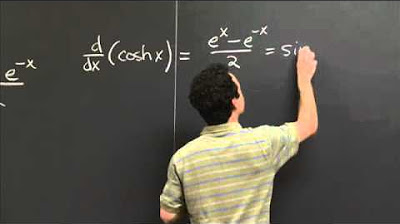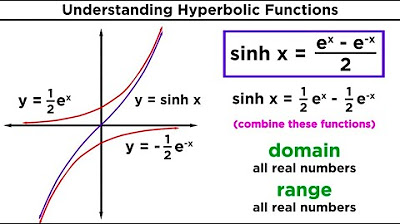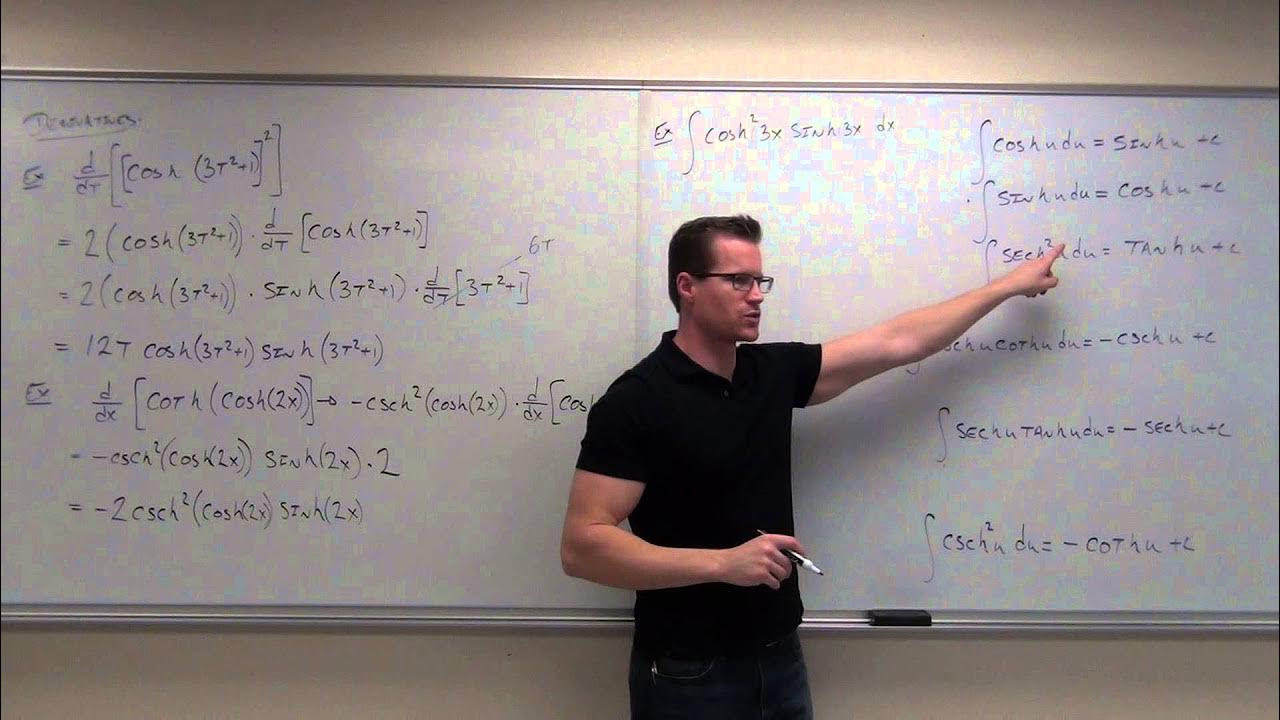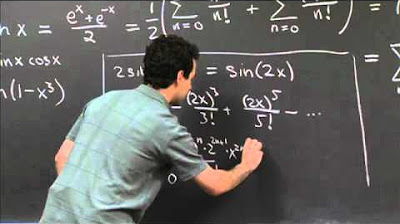Lesson 3 - Hyperbolic Functions (Calculus 2 Tutor)
TLDRThis advanced calculus tutorial introduces hyperbolic functions, which are essential for students studying engineering and physics. Hyperbolic functions, such as sine, cosine, tangent, and cotangent, have analogous versions to regular trigonometric functions but with a distinct difference in their mathematical representation. The hyperbolic sine, for instance, is derived from the complex exponential form of the sine function, with the imaginary unit 'i' omitted. The tutorial aims to explain the importance of understanding these functions and their derivatives, providing a foundational understanding before delving into problem-solving.
Takeaways
- 📚 The video is part of an advanced calculus tutorial focusing on hyperbolic functions.
- 🔍 Hyperbolic functions are important for students to know as they appear in engineering and physics studies.
- 📈 The tutorial will cover not only the functions themselves but also their derivatives, which are essential for understanding rates of change.
- 🤔 The script poses the question of why hyperbolic functions are important, emphasizing their relevance in various scientific fields.
- 📐 The hyperbolic functions have analogous counterparts to regular trigonometric functions, such as sine, cosine, and tangent.
- 👀 The script provides a brief explanation of the sine function's true form in advanced mathematics, involving complex exponentials.
- 🔁 The hyperbolic sine function is similar to the sine function but with a key difference, as it lacks the imaginary unit 'i' in its formula.
- 📘 The hyperbolic sine is defined as "e^x - e^{-x}" over 2, highlighting its relationship with the regular sine function.
- 💡 The tutorial aims to present hyperbolic functions and their derivatives, with an intention to solve problems involving these functions.
- 📝 The script serves as motivation and an introduction to the topic, with the detailed exploration of hyperbolic functions and their applications to follow.
Q & A
What is the main topic of this tutorial section?
-The main topic of this tutorial section is hyperbolic functions and their derivatives in the context of advanced calculus.
Why are hyperbolic functions important to learn?
-Hyperbolic functions are important to learn because they appear in various fields such as engineering and physics, and understanding them helps in analyzing certain systems and their behavior.
What are some of the hyperbolic functions mentioned in the script?
-The script mentions hyperbolic sine (sinh), hyperbolic cosine (cosh), hyperbolic tangent (tanh), and hyperbolic cotangent as analogous to regular trigonometric functions.
What is the significance of the 'H' in the notation for hyperbolic functions?
-The 'H' in the notation for hyperbolic functions stands for 'hyperbolic', distinguishing them from the regular trigonometric functions.
How does the hyperbolic sine function relate to the regular sine function?
-The hyperbolic sine function is similar to the regular sine function but without the imaginary unit 'i' in its complex exponential form, making it a real-valued function.
What is the complex exponential form of the regular sine function?
-The complex exponential form of the regular sine function is \( e^{i\theta} - e^{-i\theta} \) over \( 2i \), where \( e \) is the base of the natural logarithm, \( i \) is the imaginary unit, and \( \theta \) is the angle.
How is the hyperbolic sine function defined mathematically?
-The hyperbolic sine function is defined as \( e^x - e^{-x} \) over 2, where \( x \) is the input to the function.
What is the purpose of studying derivatives of hyperbolic functions?
-Studying the derivatives of hyperbolic functions is important to understand the rates of change of these functions, which is a fundamental concept in calculus.
Why does the instructor emphasize the importance of knowing what a hyperbolic function is?
-The instructor emphasizes this because hyperbolic functions are not only part of the advanced calculus curriculum but also have practical applications in fields like engineering and physics.
What does the instructor suggest about the relationship between hyperbolic and trigonometric functions?
-The instructor suggests that hyperbolic functions are analogous to trigonometric functions, with similar forms but adapted for different mathematical and physical contexts.
Outlines
📚 Introduction to Hyperbolic Functions
This paragraph introduces the topic of hyperbolic functions in the context of advanced calculus. The speaker aims to expand the viewer's mathematical knowledge by discussing hyperbolic functions, which are also covered in calculus textbooks. The importance of understanding these functions is emphasized, as they appear in fields such as engineering and physics. The paragraph also touches on the connection between hyperbolic functions and their trigonometric counterparts, highlighting that hyperbolic functions like sine, cosine, tangent, and cotangent have analogous forms to their regular trigonometric functions. The speaker uses the example of the sine function's complex exponential form to illustrate the relationship and naming convention of hyperbolic functions, specifically the hyperbolic sine function, which is derived by modifying the sine function's formula.
Mindmap
Keywords
💡Hyperbolic functions
💡Derivatives
💡Trigonometric functions
💡Hyperbolic sine (sinh)
💡Complex exponential
💡Unit circle
💡Advanced math
💡Rate of change
💡Solutions
💡Engineering and Physics
Highlights
Introduction to hyperbolic functions in the context of advanced calculus.
Hyperbolic functions are relevant in engineering and physics.
Hyperbolic functions include sine, cosine, tangent, and cotangent.
Hyperbolic sine (sinh) is analogous to the regular sine function.
The true form of the sine function is e^(iθ) - e^(-iθ) / 2i.
Hyperbolic sine is written as e^x - e^(-x) / 2.
Hyperbolic functions are derived from complex exponentials.
Hyperbolic functions are a real version of the sine function.
Hyperbolic functions will be covered in calculus textbooks.
Learning about hyperbolic functions includes understanding their derivatives.
Derivatives of hyperbolic functions are an essential part of the study.
Hyperbolic functions can be found in various systems' behavior analysis.
The importance of recognizing hyperbolic functions in advanced mathematics.
Hyperbolic functions are related to the behavior of certain systems in physics.
Hyperbolic functions are essential for students of calculus to learn.
The presentation will include hyperbolic functions and their derivatives.
Problem-solving with hyperbolic functions will be part of the session.
Transcripts
Browse More Related Video

Lesson 4 - Inverse Hyperbolic Functions (Calculus 2 Tutor)

Hyperbolic trig functions | MIT 18.01SC Single Variable Calculus, Fall 2010

Hyperbolic Functions: Definitions, Identities, Derivatives, and Inverses

Calculus 2 Lecture 6.6: A Discussion of Hyperbolic Functions

Finding Taylor's Series | MIT 18.01SC Single Variable Calculus, Fall 2010

DERIVATIVES that keep getting HARDER 🤯 | jensenmath.ca
5.0 / 5 (0 votes)
Thanks for rating: